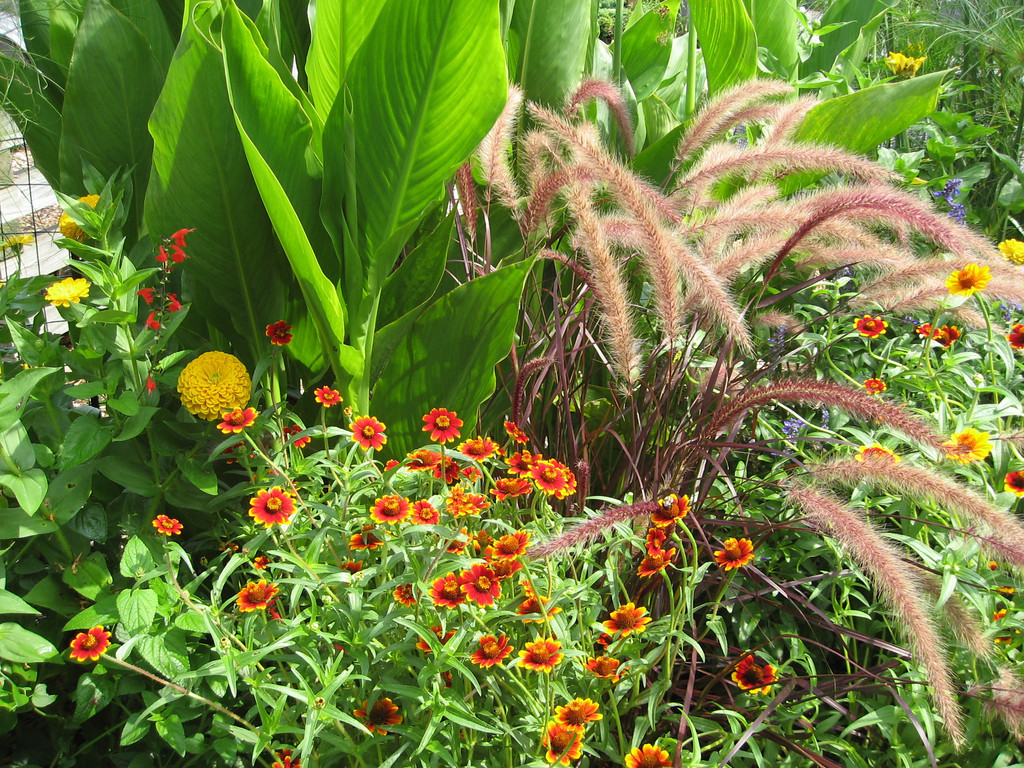
A bed of mixed annuals including tender perennials, summer bulbs, seed grown flowers and colorful grasses.
Annuals have certainly come a long way since the humble red geraniums and simple zinnias of the past. These days, nurseries are overflowing with mounds of colorful and exotic flowers of every size and shape.
So whether you’re looking to create a lavish window box, add a little curb appeal to your front walk, or just fill in a few gaps between your shrubs and perennials, an infusion of annuals may be just what your garden needs to get it from now to wow!
Technically, “annuals” are plants which complete their life cycles (grow, flower, set seed, and die) within one year or growing season. They include flowers, vegetables, herbs, ground covers, and vines. Plants labeled “tender perennials” are best treated as annuals in our hardiness zone, as they will likely not survive our winters and, therefore, will not return the next year as true perennials will.
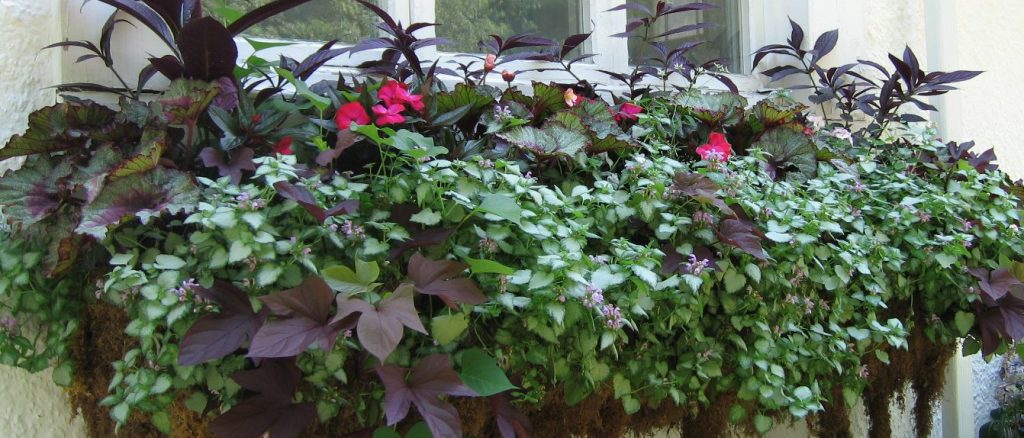
Window boxes are great for showcasing annuals. Make sure they have holes for drainage and are big enough to accommodate your plants as they grow. Because window boxes dry out quickly, they will need frequent watering. To keep soil and water from spilling out when watering, don’t fill boxes all the way up to the top with soil. Instead, leave at least half an inch of space between the soil line and the rim of the container. This allows water to puddle and slowly soak in, which not only keeps siding from being splashed with mud, but also provides plants with deeper, more effective watering.
Designing Annual Flowerbeds
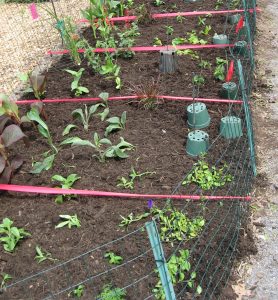
Sectioning large annual beds into grids can ensure adequate spacing between plants and make it easier for designs drawn on paper come to life.
Annual flowerbeds can be created by laying garden hose or twine on the ground until the appropriate shape is obtained. Use this marker as the pattern to edge out the bed. Bed lines can be straight or rounded, but curved lines are always more visually interesting.
Planning the design on paper with the correct spacing for a given plant will help assure that you have the right number of plants for your design. Keep taller annuals to the back of the border, and dwarfs and low annuals to the front.
In established beds, sectioning off planting grids can aid in plant placement, making sure that overall spacing is even and each variety has enough room to grow.
The sky’s the limit when it comes to color selection. There are so many vibrant primary and soft pastel colors available that endless combinations are possible. Don’t only consider flower color when it comes to annuals. Lots of annuals offer interesting foliage or interesting seed heads, even veggies can add a fun, unexpected element.
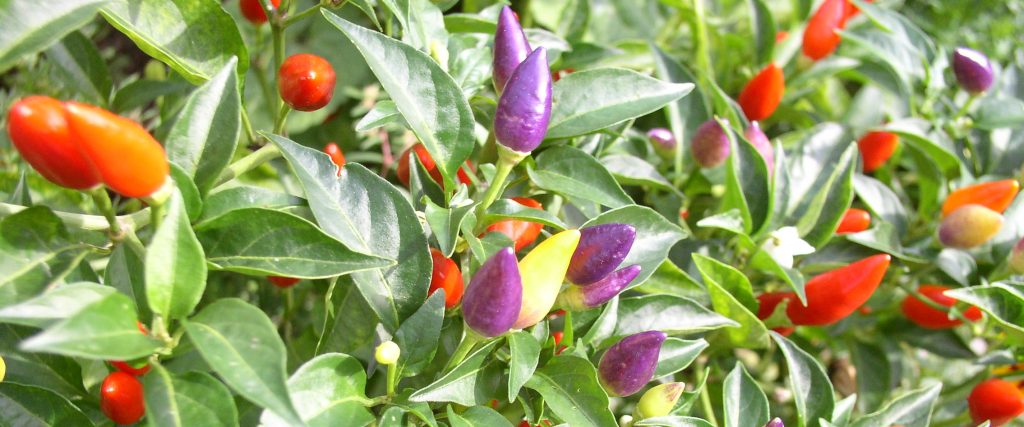
When it comes to annuals, don’t limit your thinking to flowers alone, vegetables –like these ornamental peppers– make great additions to gardens and containers.
How to Plant Annuals
SITE SELECTION: Different plants have different requirements for sun, shade, soil quality, and drainage. Most annuals prefer full sun, rich garden soil, and good drainage.
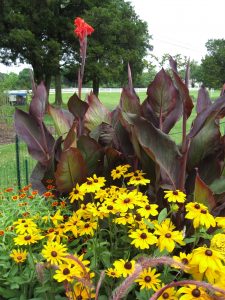
One of the best things about annuals is their incredible diversity in color, form and texture– providing exciting combinations that last all summer.
Other factors to consider when choosing where to plant your annuals are visibility, (i.e. will you be able to see and enjoy them where they are planted?) and accessibility for maintenance (will you be able to get to them to remove dead flowers, to weed, and to fertilize?) The average flower border should be no wider than 5 to 6 feet, so the middle can be accessed from both sides without stepping into the garden.
SOIL PREPARATION: Most annuals need soil that is loose enough for the roots to grow easily. Adding organic matter to heavy (clay) soil will help loosen it. Organic matter also can be added to sandy soil. For the average garden bed, add 1 inch of compost, peat moss, or well-rotted manure to the garden.
Have a soil test run to determine the pH or relative acidity. If lime is needed to raise the pH of an acid soil, apply according to soil test recommendations or use 3 to 5 lbs. of lime for each 100 sq. ft.
FERTILIZER: Annuals grow quickly and need fertilizer to nourish that growth. Use a complete fertilizer, either chemical or organic, such as 10-10-10, 5-10-10, or 5-10-5 applied at the rate of 2 lbs. per 100 sq. ft. and rake or spade into the soil before planting. Side dress at mid-season as required by individual plants. Plants may be sprayed with liquid seaweed, fish emulsion, manure or compost tea several times during the season.
PLANTING – SEED: Follow seed packet instructions for distance apart and correct depth of planting. Timing of planting is also important, because some seeds are not frost or cold tolerant and must be sown when the soil is warm. Cover the seeds with fine soil and water thoroughly.
If you raise your own plants from seed make sure they are “hardened off” for a week before transplanting. Tender plants usually sunburn or die if not hardened off by stopping fertilizer applications, lowering temperature, and increased ventilation. Gradually expose them to outdoor conditions before the transplant date.
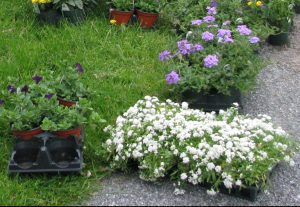
Select short, stocky plants with dark green foliage. Avoid tall, spindly plants. Small to medium-sized transplants become established in the garden more quickly than large ones.
PLANTING – TRANSPLANTS: Select healthy, robust seedlings in individual pots or 6-8 packs from your garden center. Reject any plants that appear stressed or infested with diseases or insects.
Purchase as close to planting day as possible, but be sure that plants that can’t tolerate frost aren’t planted too soon. Our frost-free date (central New Jersey) is usually near May 10. Each year varies. Don’t be so eager to get an early start that your plants will be damaged or killed by late frosts. Be prepared to cover those that may be threatened.
On an overcast day, planting can be done anytime. On a sunny day, transplant the seedlings in early morning or late afternoon so midday sun doesn’t damage them.
After removing the plants from their container, check the root system. If the roots are tightly massed and take the form or the pot, they must be cut slightly or loosened a little so they will be able to grow into the surrounding soil.
Set the plants in the ground at the same depth they were in the pot and settle soil around them gently, being sure not to leave any air pockets around the roots.
Water thoroughly. Some gardeners use a transplant solution of water-soluble fertilizer, compost tea, or liquid seaweed mixed according to the label to reduce transplant shock.
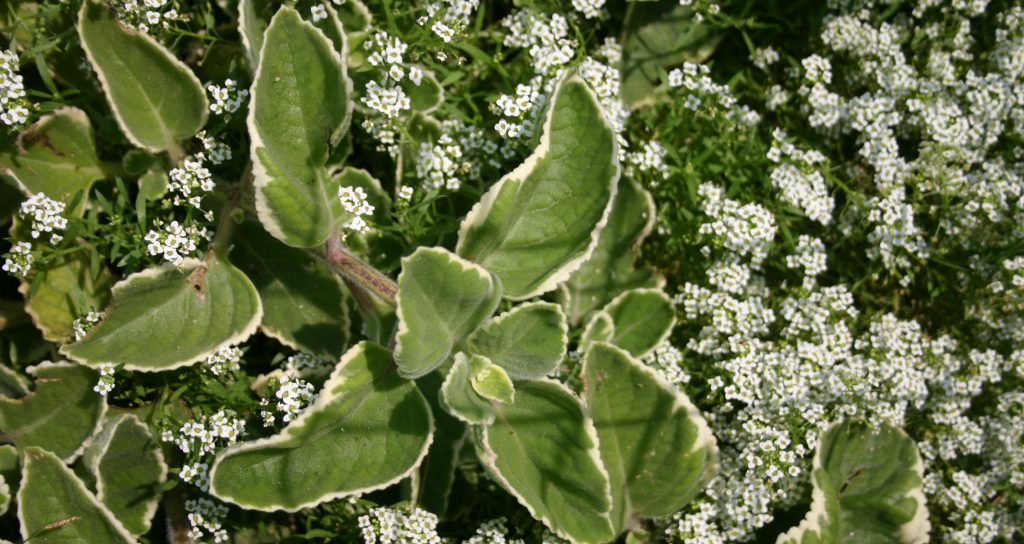
Form and Flower: A pleasing combination of alyssum and plectranthus blends the white margins of the Plectranthus with the tiny white flowers of Alyssum. The textural contrast between the two plants makes this pairing particularly charming . (Photo by Kathy Enquist)
How to Care for Annuals
WATERING: All plants need water to grow. For most annuals, watering at the rate of one inch of water per week will be enough. Use a rain gauge to determine how much rain has fallen, and reduce watering accordingly. Some plants, such as California poppy, are content with less water. When irrigating, water thoroughly, preferably in the morning. Frequent, shallow sprinkling encourages shallow root systems and disease development.
MULCHING: Using organic mulches, such as grass clippings or shredded hardwood, or inorganic mulches, such as black plastic or polyethylene weed barrier, helps to maintain even soil moisture and temperature and deters weeds. Be sure to use a little extra fertilizer (complete analysis, such as 10-6-4 or 10-10-10) when using woodchip mulches to offset the nitrogen used up in the decomposition process. Sometimes, organic mulches harbor pests such as earwigs and slugs, but this disadvantage is usually offset by the advantages of mulching.
PINCHING AND SHEARING: Some annuals, such as sweet alyssum and lobelia, benefit from pinching their tips to encourage branching or to maintain form.
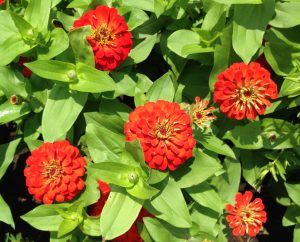
Zinnia are among the annuals that benefit from deadheading, which will help the plants remain attractive, keep them from going to seed, and increase flower production.
DEADHEADING: Removal of spent flowers to keep plants productive and to maintain an attractive appearance is called “deadheading”. Marigolds, zinnias, calendula, and others benefit from this form of pruning. Do not deadhead from early September on if seed dispersal is desired for self-sowing or if seed is going to be harvested.
SIDE-DRESSING: Annuals grow rapidly in order to complete their life cycle in one growing season. In late June or early July, applying a second application of fertilizer near, but not on, the plants, gives them a boost. Follow label directions for how much to use.
STAKING: Taller annuals, such as snapdragons and African marigolds, benefit from added support so heavy rain and wind don’t knock them over. Tomato cages, bamboo and metal stakes, are among the forms of support that can be used to keep plants upright.
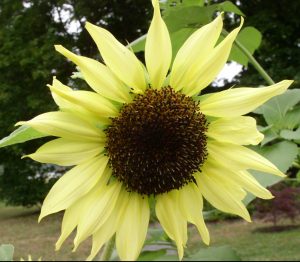
Annual sunflowers are a great addition to beds and borders. Their big, daisy-like flowers come in a variety of colors and sizes–some that tower over 16 feet in height, while others are better suited for smaller spaces and containers.
PEST CONTROL: Pests take many forms: weeds; insects; fungal, viral, and bacterial diseases; mites; mollusks (slugs); and animals. Luckily, pests don’t usually bother most annuals. Take care to keep weeds out of the flowerbed to avoid competition for available nutrients and water, especially while plants are small.
Most pest problems can be solved or controlled without the use of toxic chemicals. Before reaching for pesticide sprays , consider one of the many cultural, biological, or mechanical means at your disposal. Chemical attack should only be used as a last resort when other methods fail. The best defense against garden pests is keeping plants strong healthy, and protected by natural enemies. Consider the following for creating good growing conditions for your plants and unfavorable conditions for pests:
- When buying annuals, look for disease-resistant varieties.
- Be careful not to under or over- watering–both make plants vulnerable to insects and diseases.
- Change the location of your annuals from year to year–this helps to disrupt the life cycle of pests.
- Plant a variety of plant species — which will lessen overall damage should a pest gain a foothold and also provide welcome habitat for beneficial insects that can keep garden pests in check.
If pest problems still arise, we’re here to help! Consult with a Master Gardener from Rutgers Cooperative Extension by calling our Helpline at (609) 989-6853.
Need a Little Annual Inspiration?
Looking for some ideas for adding annuals to your own garden? Visit the Annual Garden at the Mercer Educational Gardens in Pennington. Each year Mercer County Master Gardeners select a new slate of annuals to grow from seeds and plugs. So come out and visit us –you may walk away with some fresh ideas for plants and combinations you might not have thought of before…
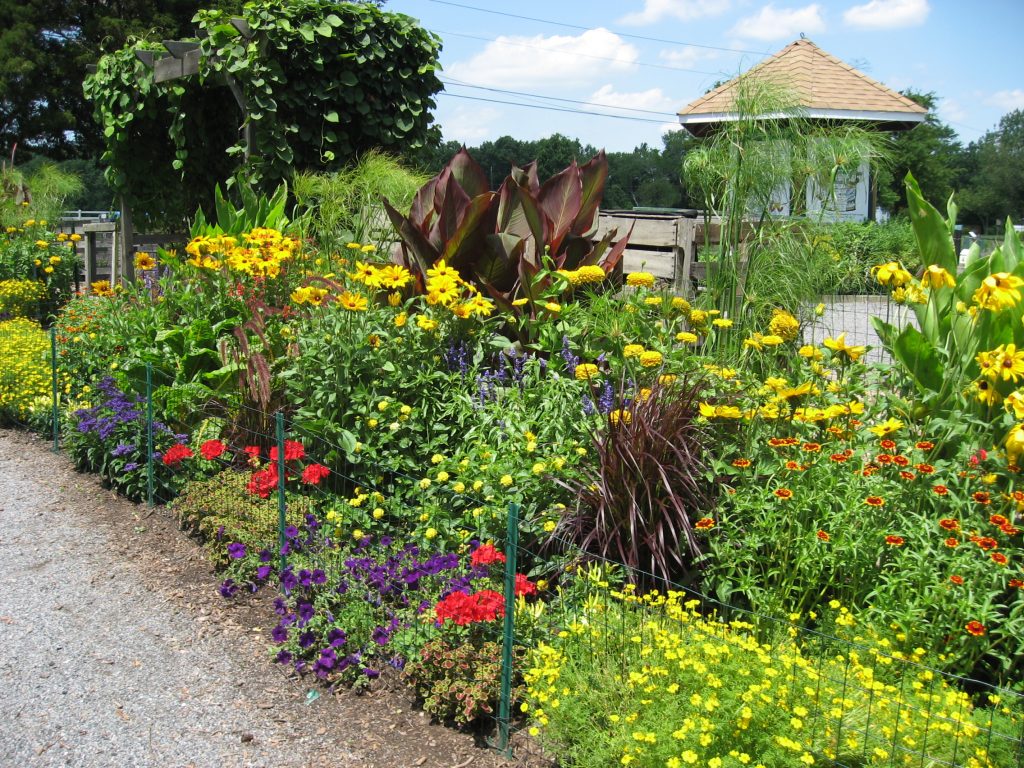
A glimpse of the annual garden at Mercer Educational Gardens in Pennington, NJ. Each year Rutgers Master Gardeners of Mercer County set out to create new color combinations and textures to bring to life two large garden beds composed entirely of annuals.
More information:
ANNUAL PLANTS FOR THE GARDEN, Barbara J. Bromley, Mercer County Horticulturist
ANNUALS FOR DIFFICULT SITES Barbara J. Bromley, Mercer Co. Horticulturist 2015
ANNUALS FOR HEAT AND DROUGHT, Barbara J. Bromley, Mercer County Horticulturist
PLANTING HIGH VISIBILITY FLOWER BEDS Barbara J. Bromley, Mercer Co. Horticulturist
BASICS of FLOWER GARDENING Barbara J. Bromley, Mercer County Horticulturist